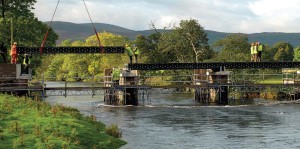In a world contending with decades-old infrastructure and more frequent dire weather events while also seeking more energy-efficient building solutions — polymer-based materials are shouldering more of the burden. From bridges and roads to roofing and buildings, innovative structures are using post-consumer plastics and advanced composites as durable and cost-effective alternatives to traditional materials.
Emergency situations — most recently the devastation in the metropolitan New York tristate area by Hurricane Sandy in 2012 — might be ideal cases for employing plastic materials in place of tried-and-true wood, concrete, or steel. Many industry experts are eyeing those opportunities more closely; training engineers to use such new materials is key, and these efforts are increasing.
For now, the efforts of the military and some forward-thinking municipalities provide benchmarks for how best to exploit plastics. Bold applications of these new materials are turning a traditionally negative view of the lifespan of plastics into an emphatic positive.
For about two decades, significant progress has been made in the use of plastic-based infrastructure elements like composite railroad ties, marina pilings, decking, energy-saving single-ply roofing, and building insulation. Perhaps most impressive have been advances in thermoplastic high-load bridges capable of holding a 73-ton tank or an 88-ton wheeled vehicle. There is even emerging technology that exploits polymer properties in economical and environmentally friendly paving.
Advanced production methods are turning out larger structural components that simplify installation. Plastics are also saving up-front project costs as well as long-term expenditures because of the maintenance-free characteristics they impart; makers of these components are guaranteeing they’ll last more than three decades and beyond. In the case of heavy-duty structures, polymer-based components are shaped at much lower temperatures than steel, reducing energy costs — and weighing in far lighter. Moreover, replacing the traditional materials means avoiding wood-preserving toxins or asphalt fumes and fires.
Rethinking Bridges, Roads, and Rails
While California and Europe tend to spring to mind as leaders in environmental consciousness, Rutgers University in New Jersey has been leading the charge to recycle and repurpose consumer plastics since the mid-1980s.
A simple but unheard-of-at-the-time project to collect used soda bottles from residents in nearby Highland Park eventually blossomed into the first forays into creating plastic lumber using reclaimed high-density polyethylene (HDPE) blended with polystyrene (PS), and HDPE blended with reclaimed automotive bumper scrap. That led to the initial structural uses of plastic lumber in railroad ties, and eventually to the heavy-load bridges that have been incorporating the material invented at the Rutgers AMIPP Advanced Polymer Center in Piscataway.
Momentum is building for these thermoplastic wonders, from the first pivotal vehicular bridge installed at Fort Leonard Wood, Missouri, in 1998, to subsequent structures at New Jersey’s Wharton State Forest in 2002, Fort Bragg in North Carolina in 2009, and a pair of railway bridges at Fort Eustis in Virginia in 2010. Rutgers’ New Jersey-based manufacturing partner Axion International has since advanced the technology into multiple uses with bridges in York, Maine; Logan County, Ohio; Ventura, California; and Peeblesshire, Scotland. The Fort Eustis and Scotland bridges employed prefabricated recycled thermoplastic composite lumber (RTCL) panels.

